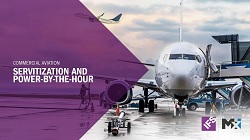The fundamental shift from selling products to guaranteed outcomes has been aided by exponential technological growth over the last ten years.
The concept of “Power-by-the-Hour” was invented by Rolls-Royce in 1962, which means it has been in play in the commercial aviation industry for more than 50 years. This program has reshaped the relationship between suppliers and customers, providing a performance-based product/services bundle (servitization) rather than the traditional acquisition of a long-life asset. The approach is known in defense and aviation contracting as “Performance-Based Logistics (PBL).” This fundamental shift to selling the outcome (you only pay when your asset is up and running) has been aided by the exponential growth in technology over the last decade.
Such an offering is appealing to both suppliers and consumers. Profits are significantly higher for suppliers. Support and maintenance services can generate “up to seven times as much profit as do sales of original products over the lifetime of product use,” according to a Power-by-the-Hour research paper from Wharton Business School. Additionally, when tying risks and incentives to the performance of an asset rather than the asset itself, customers also benefit. With the pressure on the supplier to ensure the success of their asset, customers benefit from more reliable up-time and more responsive service.
So, what’s changed? If customers have been paying for results rather than one-off transactions for years, why is now the time for organizations, such as maintenance, repair and overhaul (MRO) service providers, to pay close attention? The truth is, digital transformation is taking performance-based service contracts to the next level, and industry laggards will suffer. In fact, there are three key technologies that are making Power-by-the-Hour contracts that much more competitive and changing the service model completely.
The three technologies taking service to the next level
1. The Internet of Things (IoT)
In today’s application, sensors across an aircraft can collect up to 10 TB of data per flight. With the right systems in place, this data can be monitored and applied to all aviation segments and aircraft operations. Manufacturers get performance data from their fleets to influence design (performance) and production. Operators get information on available aircraft, customer behavior, etc. OEMs and third-party MRO providers get information on aircraft performance, key performance indicators, as well as valuable diagnostic info.
What does this mean for a supplier offering Power-by-the-Hour contracts? Suppliers now have the ability to provide more proactive service from airplanes during flight and upon landing. They can identify issues and required/needed parts before arrival in the hangar to streamline the supply chain and provide faster service times and uptimes.
2. Automation
Modern MRO is a complex enterprise with many moving parts. Automation of key business processes and systems has allowed suppliers to increase efficiencies and response times. In conjunction with IoT and big data, automation streamlines maintenance services by ensuring a technician with the right skill set is performing the right maintenance on the right part of the aircraft with the right tools and parts, all without human interference or hold-ups.
3. Big data
In general, aviation is a data rich-industry – many would claim it is already in data-overload. New IFS research from Raconteur suggests that 76% of businesses within aviation are utilizing data-driven insights. However, only 32% of that number claim they are gaining a competitive advantage from these insights and positively benefiting from data.
Big data is key to the necessary insights service providers need to act and provide a higher level of service and outcome to their consumer. Big data not only helps suppliers increase efficiencies in wrench turning but also helps identify opportunities to address outages in the larger asset management lifecycle while optimizing against service levels.
 To learn more about how your peers are embracing digital transformation as part of their service delivery, download the Commercial Aviation: Servitization and Power-by-the-Hour eBook.
To learn more about how your peers are embracing digital transformation as part of their service delivery, download the Commercial Aviation: Servitization and Power-by-the-Hour eBook.
Do you have questions or comments about Power-by-the-Hour contracts or servitization?
We’d love to hear them so please leave us a message below.